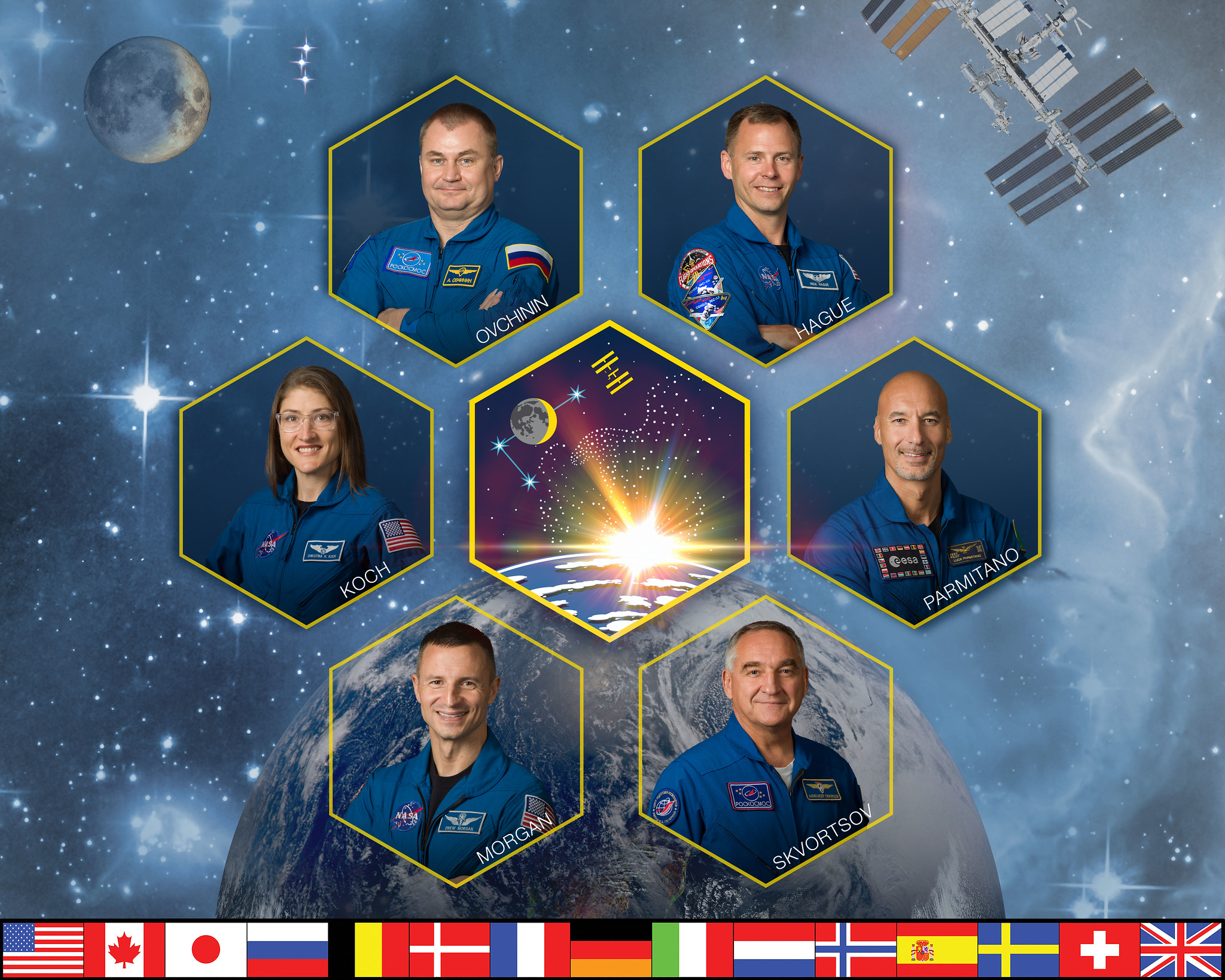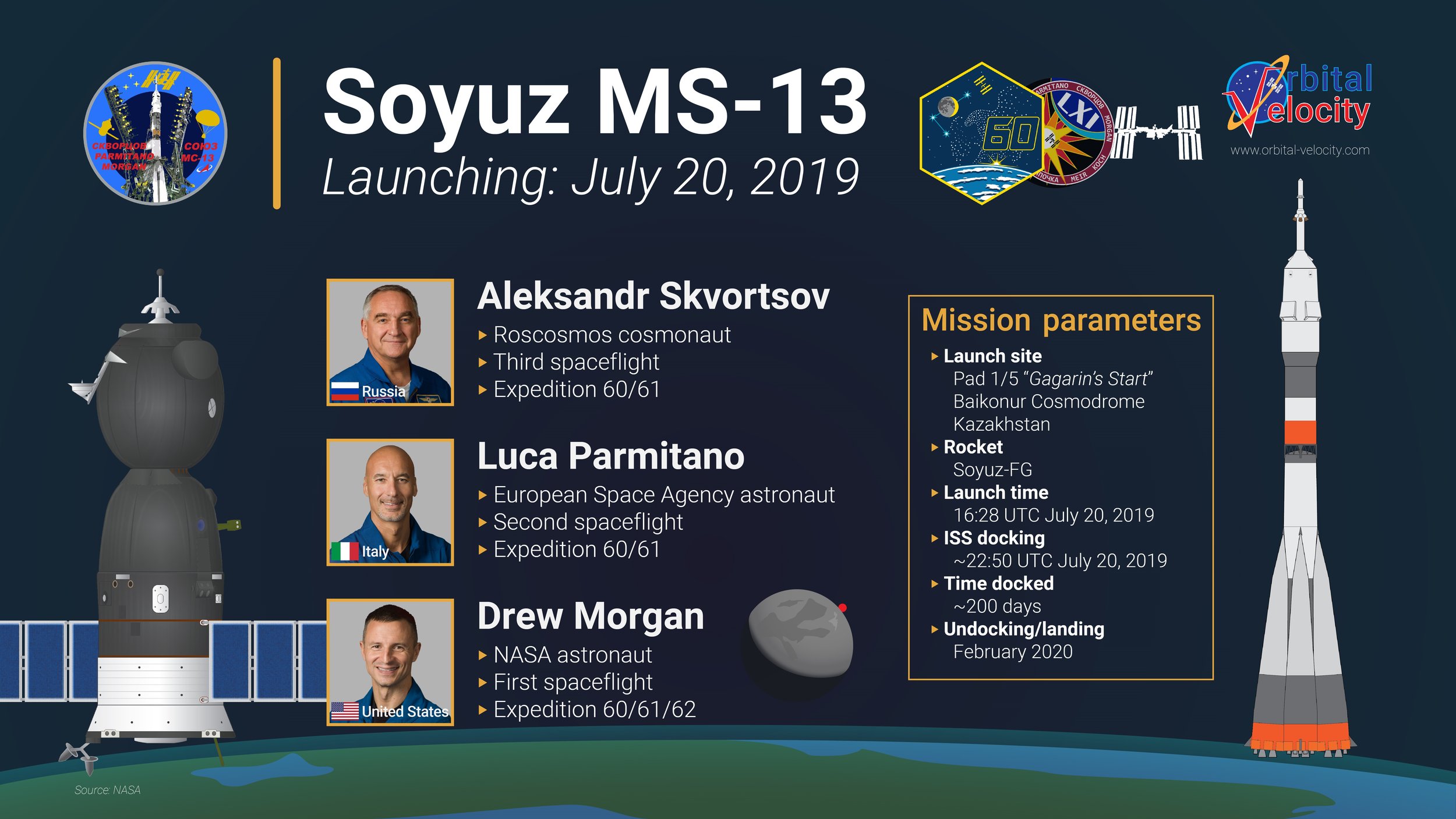Expedition 60
/Began June 24, 2019; transitioned to Expedition 61 on Oct. 3, 2019
First Part
Transferred from Expedition 59
Aleksey Ovchinin, Roscosmos
| Commander
Nick Hague, NASA
| Flight Engineer
Christina Koch*, NASA
| Flight Engineer
Launched: March 14, 2019, aboard Soyuz MS-12
Landed: Oct. 3, 2019
Second Part
Docked July 20, 2019
Aleksandr Skvortsov, Roscosmos
| Flight Engineer
Drew Morgan**, NASA
| Flight Engineer
Luca Parmitano, ESA
| Flight Engineer
Launched: July 20, 2019, aboard Soyuz MS-13
Expected landing: Feb. 6, 2020
* Koch is expected to stay aboard the ISS for an additional four months. She flew into space March 14, 2019, aboard Soyuz MS-12 and should land with the Soyuz MS-13 crew in February 2020.
** Morgan is also expected to stay aboard the ISS for an additional month. He is slated to fly to the outpost on July 6, 2019, aboard Soyuz MS-13 and should land with the Soyuz MS-15 crew in March 2020.

— Statistics —
Max. crew size: 6
Started: June 24, 2019
Ended: Oct. 3, 2019
Duration: 103 days
Orbits of Earth: ~1,600
Launch site: Baikonur Cosmodrome, Kazakhstan
Spacecraft: Soyuz-MS-12, Soyuz MS-13
Spacewalks: 1
Total spacewalk time: 6 hours, 32 minutes
Visiting vehicle arrivals: 4
Visiting vehicle departures: 4
— Mission Summary —
Expedition 60, which took place during the time of the 50th anniversary of the Apollo 11 Moon landing, had a mission to perform a number of experiments, including 3D printing organ-like tissues, examining the physical interactions of liquid, rocks and microorganisms, evaluating the creation of “novel” silica forms and structures and analyzing the spreading and penetration of a liquid on porous surfaces, according to NASA’s mission summary.
— Major Events —
Expedition 60 begins
At 23:25 UTC June 24, 2019, Soyuz MS-11 undocked from the International Space Station’s Poisk module. Aboard were Russian cosmonaut Oleg Kononenko, NASA astronaut Anne McClain and Canadian Space Agency astronaut David Saint-Jacques. They left the outpost after 204 days in space.
Upon undocking, Expedition 59 ended and the trio that remained aboard the ISS — Russian cosmonaut Aleksey Ovchinin and NASA astronauts Nick Hague and Christina Koch — transitioned to Expedition 60 with Ovchinin as its commander.
Soyuz MS-13 arrival
As the world celebrated the 50th anniversary of the Apollo 11 lunar landing, three people left Earth to join the International Space Station’s Expedition 60 crew.
On July 20, 2019, Ovchinin, Hague and Koch were joined by the crew of Soyuz MS-13 — Russian cosmonaut Aleksandr Skvortsov, NASA astronaut Drew Morgan and European Space Agency astronaut Luca Parmitano — returning the crew complement of the ISS to six following the June 25 departure of Soyuz MS-11.




Liftoff atop a Soyuz-FG rocket took place at 16:28 UTC July 20, 2019, from Baikonur Cosmodrome. After reaching orbit some nine minutes later, the spacecraft began a process to catch up with the ISS over the course of about six hours.
Docking with the aft port of the Zvezda service module took place at 22:48 UTC while the spacecraft were flying some 400 kilometers over southern Russia just northeast of the Black Sea, according to NASA.
It took about two hours for the incoming crew to pressurize the space between the hatches of the ISS and Soyuz and perform leak checks. The official opening time was at 01:04 UTC July 21.
The incoming space flyers were welcomed by Russian cosmonaut and station commander Ovchinin, Hague and Koch, bringing Expedition 60 to its full six-person crew size.
According to NASA, the three new crew members, who will transition to Expedition 61 in October, are expected to perform some 250 science investigations in biology, Earth science, human research, technology development and more.
CRS-18 Dragon arrival
Carrying 2,312 kilograms of cargo, including a new docking adapter for commercial crew spacecraft, the CRS-18 Dragon spacecraft took two days following its launch to catch up to the space station.
The vehicle then placed itself about 10 meters beneath the Destiny module before Hague and Koch remotely commanded the robotic Canadarm2 to capture the spacecraft at 13:11 UTC July 27, 2019.



Dragon launched into space atop a Falcon 9 rocket at 22:01 UTC July 25 from Cape Canaveral Air Force Station’s Space Launch Complex 40 if Florida. It took less than 10 minutes for the partially-reusable two-stage rocket to place CRS-18 into orbit, beginning it’s two-day chase of the outpost.
Following its capture at ISS, teams on the ground then remotely commanded the arm to position Dragon just below the Earth-facing port of the Harmony module in preparation for berthing. The spacecraft was officially attached to the space station at 16:01 UTC.
This is the third time this particular spacecraft has visited the ISS and is the first time that a thrice-flown Dragon has made its way into space, having been used for the CRS-6 and CRS-13 missions in April 2015 and December 2017, respectively.
Possibly the most anticipated piece of hardware aboard CRS-18 is the third International Docking Adapter, also known as IDA-3, which is located in Dragon’s trunk.
IDA-3 is expected to be removed from the unpressurized trunk of Dragon sometime in August before being positioned in front of Pressurized Mating Adapter-3, which itself is located on the space-facing port of the Harmony module. It will require at least one spacewalk by astronauts to finish the installation of the docking ring before it is certified for use by a commercial crew vehicle.
Progress MS-11 departs, Progress MS-12 arrives
On July 29, the Russian Progress MS-11 cargo freighter departed the ISS with trash and other unneeded equipment. It spent the last four months docked to the Pirs module.
This departure cleared the port of the arrival of the next Progress spacecraft, Progress MS-12. The spacecraft was lofted into orbit atop a Soyuz-2.1a rocket at 12:10 UTC July 31 from Baikonur Cosmodrome. Inside was some 2,400 kilograms of hardware and crew supplies bound for the outpost and its six-person Expedition 60 crew.
Docking with the Pirs module occurred just 3.5 hours later, marking the third time this super-fast-track rendezvous profile was utilized. The first time was in July 2018 with Progress MS-09. At some point, it is hoped crewed Soyuz flights will fly the same profile.
Monitoring the automated docking from inside the ISS were Russian cosmonauts Aleksey Ovchinin and Aleksandr Skvortsov. Were it needed, they could have taken over control of the spacecraft remotely from a manual docking system in the Zvezda module called TORU.
However, everything went by the book with a successful docking at 15:29 UTC.
Progress MS-12 is slated to remain aboard the ISS until December 2019. At the end of its mission, it will be loaded with trash and unneeded equipment before being undocked and commanded to de-orbit and burn up in the atmosphere over the southern Pacific Ocean near an area called Point Nemo. Sometimes called the “spacecraft cemetery,” this is an area in the ocean that is the farthest from land — some 2,600 kilometers — and has relatively little maritime traffic.
NG-11 Cygnus departs ISS, begins extended mission
Northrop Grumman’s NG-11 Cygnus departed the International Space Station following its 3.5-month stay aboard the orbiting laboratory, beginning a multi-month free-flying secondary mission.
Using the robotic Canadarm2, the NG-11 Cygnus was unberthed Aug 6, 2019, from the Earth-facing port of the Unity module and positioned about 10 meters below the Destiny laboratory module. It was officially released at 16:15 UTC to slowly move away from the ISS.
It was the fourth visiting vehicle coming or going in the last 10 days after the arrivals of CRS-18 Dragon and Progress MS-12 on July 27 and 31, and the departure of Progress MS-11 on July 29.
After 109 days at the space station, the crew loaded the vehicle with trash and unneeded equipment. The Expedition 60 astronauts then shut the Cygnus hatch. But before closing the ISS-side, they outfitted the spacecraft with the SlingShot Deployer, a device built by SEOPS that is designed to deploy CubeSats once Cygnus is at an altitude higher than the ISS sometime after its departure, according to NASA.
Other CubSats will be released via an external deployer provided by NanoRacks located on the spacecraft’s service module.
This mission is the last for Northrop Grumman for the first Commercial Resupply Services contract. Starting with NG-12 in October, Cygnus spacecraft will be flying under CRS2, which calls for a minimum of six launches by the company.
However, the NG-11 mission isn’t over. In addition to its usual post-unberthing CubeSat deployment activities, which typically don’t last more than several weeks, the spacecraft is expected to test a number of new systems, such as a control moment gyroscope attitude control system, and showcase the longevity of the spacecraft. This means the vehicle will remain in orbit on an extended free-flying mission until at least December.
This is also expected to demonstrate Northrop Grumman’s ability to operate two Cygnus spacecraft at the same time once the NG-12 cargo ship launches in October.














With Soyuz MS-12 safely back on Earth, the remaining six-person International Space Station Expedition 61 crew is preparing for nearly a dozen spacewalks over the next several months.